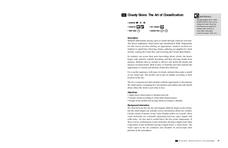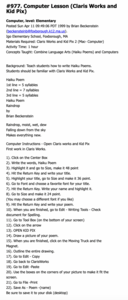Curated OER
DEW POINT
Fourth graders investigate conditions causing saturation and measure the dew point of the atmosphere performing simple experiments.
Curated OER
Dew Point
Fourth graders investigate saturation conditions and measure the dew point. They conduct an experiment, record data on a worksheet, and measure the dew point in the experiment.
Curated OER
Phase Changes of Water
A micro-unit on the phase changes of water includes three laboratory activities. Junior scientists compare the densities of ice and water, and then they do the same for cold and warm water. They examine freezing and boiling temperatures....
Curated OER
Does Humidity Affect Cloud Formation?
Students use S'COOL data to identify factors that affect cloud formation. They find a data set using the S'COOL database , and use Excel to manipulate the data. Student isolate relevant data, create meaningful graphs from a spreadsheet,...
Curated OER
Water Web-- Weather: Something We Talk a Lot About But Can't Change
In this science learning exercise, students study weather prediction by reading and completing activities in this 8 page newsletter. Students classify clouds, study weather prediction instruments, learn weather proverbs and signs and...
Calvin Crest Outdoor School
Survival
Equip young campers with important survival knowledge with a set of engaging lessons. Teammates work together to complete three outdoor activities, which include building a shelter, starting a campfire, and finding directions in the...
Kenan Fellows
Sensors, Sensors…..Everywhere! Middle School Meteorologist Create Weather Bots!
My forecast is that you'll want to use the resource. Pupils design and create a weather bot as part of a project-based unit. These bots should be able to measure temperature, humidity, barometric pressure, wind speed and direction, and...
National Institute of Open Schooling
The Liquid State
Due to surface tension, dew — a liquid, is spherical in shape. Learners explore the properties of liquids in activity seven in this series of 36. Beginning with its basic properties such as boiling point and moving through to surface...
Curated OER
Clouds & Condensation
Students use the digital atlas of Idaho to study different weather patterns. They use the Climatology section of the Digital Atlas of Idaho to explore concepts such as relative humidity, dew point, condensation, and cloud formation.
Curated OER
How Do You Dew?
Students examine how the processes of condensation and evaporation occur. They describe the relationship between heat energy, evaporation and condensation of water on Earth. They give examples of the processes of evaporation and...
Curated OER
Sun and Earth
Students explore the sun, its structure, how big it is and how far away it is. In this solar system instructional activity students complete a lab activity on dew point and weather.
Curated OER
Weather Elements and Instruments
Eighth graders identify the different weather elements. In this earth science lesson, 8th graders explain the difference between relative humidity and dew point. They discuss the different instruments used to predict weather.
Bekshire Museum
Cloudy Skies: The Art of Classification
Such a great resource and perfect for learners in Kindergarten through third grade. The class will discuss cloud types and formation, and then they'll get outside and draw as they observe the clouds they see. They'll need to take note of...
Curated OER
Cold Front Characteristics
Students study weather characteristics of a cold front passage. They view animations of several atmospheric variables (e.g., temperature, rainfall) during a cold front passage and locate the front, determine its direction of movement,...
Curated OER
Computer Lesson
The writing of Haiku poems is the focus of this language arts instructional activity. In it, the basic elements of Haiku poetry are presented, and then a step-by-step set of instructions on how to create a Haiku poem along with an...
Curated OER
Online Project Center
Students write two haiku poems in appropriate form. Writing haiku allows students to practice in the skills of dividing words into syllables, counting syllables, and searching for words to fit a structure.
Curated OER
Moist Air & Clouds
Fifth graders study the weather and water cycle of clouds. For this water cycle lesson, 5th graders read background information about evaporation, condensation, and the states of water.
Curated OER
Clouds and Precipitation Review
In this science worksheet, students review the concepts that tie the relationship of clouds and how they collect precipitation in response to changes in humidity.
Curated OER
Classification of Clouds
Students view a cloud slide show presentation and identify types of clouds. They estimate height based on cloud's appearance. They discuss the vague nature of cloud nomenclature and compare it to the English standard measurement system.
Curated OER
Does Humidity Affect Cloud Formation?
Learners use NASA's S'COOL database to identify factors that affect cloud formation.
Curated OER
Classification of Clouds
Students view progressive slides of cloud formations and identify which type of cloud is shown as it forms. They estimate the cloud's height while viewing each image.
Curated OER
Weather v. Climate
Ninth graders discuss the differences between climate and weather as a class. Using data they collected, they create a graph of the data to share with the class over a specific time period. They compare and contrast this data with...
Curated OER
Dryline Characteristics
Students view animations of several atmospheric variables (e.g., temperature, rainfall) during a cold front passage and locate the dryline, determine its direction of movement, and list at least two weather conditions associated with the...
Curated OER
Weather Plots
Students investigate the relationship between temperature and humidity. The graphs of weather data gathered and plotted for for an assigned period of time are analyzed and the interpretations shared with the class.























